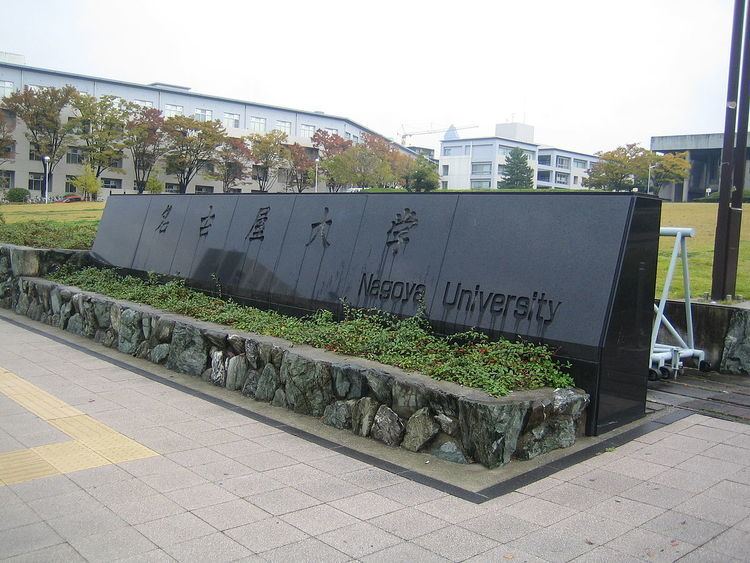Type Public (National) Academic staff 1,793 Postgraduates 5,993 Total enrollment 16,439 (1 May 2015) Color Green | President Seiichi Matsuo Undergraduates 9,818 Acceptance rate 40.7% (2015) Phone +81 52-789-5111 | |
 | ||
Established Founded 1871,Chartered 1939 Motto 勇気ある知識人 (courageous intellectual) Undergraduate tuition and fees Domestic tuition: 535,800 JPY (2013), International tuition: 359,400 JPY (2013) Notable alumni Similar Kyoto University, Osaka University, Tohoku University, University of Tokyo, Tokyo Institute of Technology Profiles | ||
Nagoya university international programs challenge experience future
Nagoya University (名古屋大学, Nagoya daigaku), abbreviated to Meidai (名大), is a Japanese national university headquartered in Chikusa-ku, Nagoya. It was the last Imperial University in Japan and among the National Seven Universities. It is the 3rd best ranked higher education institution in Japan (72nd worldwide).
Contents
- Nagoya university international programs challenge experience future
- History
- Student population
- Faculties
- Graduate schools
- Academic rankings
- General rankings
- Research performance
- Graduate school rankings
- Alumni rankings
- Popularity and selectivity
- Notable alumni and affiliates
- References
As of 2014, the university has produced six Nobel Prize winners in science, the third most in Japan behind Kyoto University and the University of Tokyo.
History
Nagoya University traces its roots back to 1871 when it was a temporary medical school. In 1939 it became Nagoya Imperial University. In 1947 it was renamed Nagoya University, and became a Japanese national university. In 2004 it became a Japanese national university corporation.
The ideal written in the Nagoya University academic charter is to encourage the intelligentsia with courage by providing an education which respects independent thought.
In March 2012 the university played host to the International Symposium on Innovative Nanobiodevices.
Student population
While the majority of its students come from Tōkai region, Nagoya University has a good portion of students from all over Japan.
It also receives many students from abroad. Currently there are over 1300 foreign students (150 undergraduate) from 78 countries studying in the faculties of Nagoya University. The majority of them are from China (47%, as of May 1, 2009) and Korea (9.5%). Among other countries, Taiwan, Indonesia, Viet Nam, Malaysia, Cambodia and Uzbekistan are represented by more than 30 students. The United States and Brazil with 16 students each are the most represented non-Asian countries.
Faculties
Graduate schools
The University's Research Center for Seismology, Volcanology and Disaster mitigation is represented on the national Coordinating Committee for Earthquake Prediction.
Academic rankings
Nagoya University is one of the most prestigious universities in Japan. This can be seen in several rankings such as the ones shown below.
General rankings
The university has been ranked 15th in 2009 and 21st in 2010 in the ranking "Truly Strong Universities" by Toyo Keizai. In another ranking, Japanese prep school Kawaijuku ranked Nagoya as the 8th best university in Japan.
The Academic Ranking of World Universities (ARWU) 2009 ranks Nagoya University as fourth in Japan. The 2009 THE-QS World University Rankings (From 2010 two separate rankings will be produced by the Times Higher Education World University Rankings and the QS World University Rankings) ranks Nagoya University as fifth in Japan. The 2010 QS Asian University Rankings rated Nagoya number ten in Asia and number five in Japan, while the QS World University Rankings for 2011 ranked Nagoya 80th in the world.
Research performance
Nagoya is one of the top research institutions in Japan. According to Thomson Reuters, Nagoya is the 5th best research university in Japan. Its research standard is especially high in Physics (6th in Japan, 61st in the world), Chemistry (7th in Japan, 43rd in the world), and Biology & Biochemistry (5th in Japan, 97th in the world).
Weekly Diamond reported that Nagoya has the 6th highest research standard in Japan in research funding per researchers in COE Program. In the same article, it's also ranked 6th in terms of the quality of education by GP funds per student.
In addition, Nikkei Shimbun on 16 February 2004 surveyed the research standards in Engineering studies based on Thomson Reuters, Grants in Aid for Scientific Research and questionnaires to heads of 93 leading Japanese research centers, and Nagoya was placed 9th (research planning ability 5th//informative ability of research outcome 9th/ability of business-academia collaboration 6th) in this ranking.
Furthermore, Nagoya had the 8th highest number of patents accepted (108) in 2009 among Japanese universities.
It has a high research standard in Social Science & Humanities. Asahi Shimbun summarized the amount of academic papers in Japanese major legal journals by university, and Nagoya University was ranked 4th during 2005-2009. RePEc in January 2011 ranked Nagoya's Economic department as Japan's 13th best economic research university.
Graduate school rankings
Nagoya Law School is considered one of the top law schools in Japan, as it was ranked 10th in the pass rate of the Japanese Bar Examination in 2010.
Alumni rankings
According to the Weekly Economist's 2010 rankings, graduates from Nagoya have the 38th best employment rate in 400 major companies in Japan.
Popularity and selectivity
Nagoya is one of the most selective universities in Japan. Its entrance difficulty is usually considered one of the highest in Japan.
Notable alumni and affiliates
Full list can be found in the Japanese Wikipedia article: List of Nagoya University people (in Japanese)It includes six Nobel Prize winners.
It includes one Fields Medalist.
There are several world-class scientists:
Other notable alumni:
